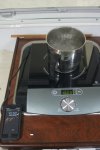Iain_U1250
Explorer
I looked at them and was really tempted as they were cheaper than the whole kit I ended up with, and whole lot simpler to install. It is a really nice compact solution for providing hot water and warming the camper.
What swayed me to the 90ST is that I wanted something that would be able to heat the engine block as well, as we plan on traveling to northern Europe ( Norway/Sweden) in winter to see the northern lights. I did some heat calculations a while back, and needed around 4-5kw to keep us warm when it is -20C outside. The "spare" 4-5kw should be enough to stop the engine from freezing we hope. I know that Charlie has a 90ST just to heat his engine for his Unimog U500 and another 5kw unit for the camper, but his truck is a lot bigger than mine and he travels in really cold places.
The other advantage of what we ended up with is that the engine heat is used to heat up the hot water system. That is the main advantage of what I have, I don't have to fire up the 90ST for hot water at all if we are moving regularly as the calorifier would retain enough heat to let us have a shower the next morning, and according to a few people, sometimes two days. We can also use the residual engine heat to warm the truck in the evenings, even after stopping thanks to the EBP.
I was also considering having the 90ST closer to the middle of the truck, under the floor, rather than where we have it. After hearing one start up, I decided to put it as far away from the bed area as possible, so moved it. It is not that loud, but does sound like a mini jet engine on start up, once it is going, it get quieter. I'm not sure how quiet the DuoTop is, have not heard one run.
When we camp, it is unbelievable how quiet things are out in the bush, so I am doing my best to keep all the stuff in the truck as quiet as possible, I'm even replacing all the fans on the fridge and freezer with more silent magnetic bearing fans, and sealing the front of the fridge cabinet, adding sound insulation. Adding all this sound insulation then requires ventilation fans around the fridge cabinet to get the hot air outside, so everything is a compromise.
What swayed me to the 90ST is that I wanted something that would be able to heat the engine block as well, as we plan on traveling to northern Europe ( Norway/Sweden) in winter to see the northern lights. I did some heat calculations a while back, and needed around 4-5kw to keep us warm when it is -20C outside. The "spare" 4-5kw should be enough to stop the engine from freezing we hope. I know that Charlie has a 90ST just to heat his engine for his Unimog U500 and another 5kw unit for the camper, but his truck is a lot bigger than mine and he travels in really cold places.
The other advantage of what we ended up with is that the engine heat is used to heat up the hot water system. That is the main advantage of what I have, I don't have to fire up the 90ST for hot water at all if we are moving regularly as the calorifier would retain enough heat to let us have a shower the next morning, and according to a few people, sometimes two days. We can also use the residual engine heat to warm the truck in the evenings, even after stopping thanks to the EBP.
I was also considering having the 90ST closer to the middle of the truck, under the floor, rather than where we have it. After hearing one start up, I decided to put it as far away from the bed area as possible, so moved it. It is not that loud, but does sound like a mini jet engine on start up, once it is going, it get quieter. I'm not sure how quiet the DuoTop is, have not heard one run.
When we camp, it is unbelievable how quiet things are out in the bush, so I am doing my best to keep all the stuff in the truck as quiet as possible, I'm even replacing all the fans on the fridge and freezer with more silent magnetic bearing fans, and sealing the front of the fridge cabinet, adding sound insulation. Adding all this sound insulation then requires ventilation fans around the fridge cabinet to get the hot air outside, so everything is a compromise.



